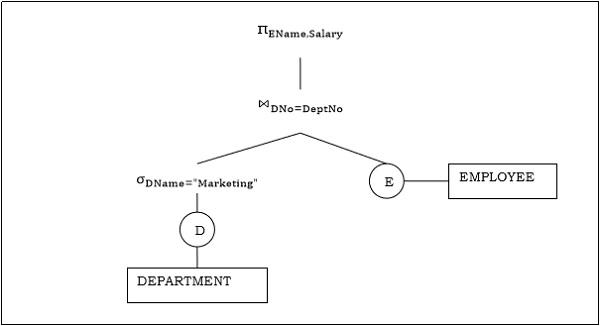
- Distributed Database Environments
- DDBMS - Design Strategies
- DDBMS - Distribution Transparency
- DDBMS - Database Control
- Query Optimization
- Relational Algebra Query
- Query Optimization Centralized
- Query Optimization in Distributed
- Concurrency Control
- Transaction Processing Systems
- DDBMS - Controlling Concurrency
- DDBMS - Deadlock Handling
- Failure and Recovery
- DDBMS - Replication Control
- DDBMS - Failure & Commit
- DDBMS - Database Recovery
- Distributed Commit Protocols
- Distributed DBMS Security
- Database Security & Cryptography
- Security in Distributed Databases
- Distributed DBMS Resources
- DDBMS - Quick Guide
- DDBMS - Useful Resources
- DDBMS - Discussion
Query Optimization in Centralized Systems
Once the alternative access paths for computation of a relational algebra expression are derived, the optimal access path is determined. In this chapter, we will look into query optimization in centralized system while in the next chapter we will study query optimization in a distributed system.
In a centralized system, query processing is done with the following aim −
Minimization of response time of query (time taken to produce the results to users query).
Maximize system throughput (the number of requests that are processed in a given amount of time).
Reduce the amount of memory and storage required for processing.
Increase parallelism.
Query Parsing and Translation
Initially, the SQL query is scanned. Then it is parsed to look for syntactical errors and correctness of data types. If the query passes this step, the query is decomposed into smaller query blocks. Each block is then translated to equivalent relational algebra expression.
Steps for Query Optimization
Query optimization involves three steps, namely query tree generation, plan generation, and query plan code generation.
Step 1 − Query Tree Generation
A query tree is a tree data structure representing a relational algebra expression. The tables of the query are represented as leaf nodes. The relational algebra operations are represented as the internal nodes. The root represents the query as a whole.
During execution, an internal node is executed whenever its operand tables are available. The node is then replaced by the result table. This process continues for all internal nodes until the root node is executed and replaced by the result table.
For example, let us consider the following schemas −
EMPLOYEE
| EmpID | EName | Salary | DeptNo | DateOfJoining |
DEPARTMENT
| DNo | DName | Location |
Example 1
Let us consider the query as the following.
$$\pi_{EmpID} (\sigma_{EName = \small "ArunKumar"} {(EMPLOYEE)})$$
The corresponding query tree will be −

Example 2
Let us consider another query involving a join.
$\pi_{EName, Salary} (\sigma_{DName = \small "Marketing"} {(DEPARTMENT)}) \bowtie_{DNo=DeptNo}{(EMPLOYEE)}$
Following is the query tree for the above query.

Step 2 − Query Plan Generation
After the query tree is generated, a query plan is made. A query plan is an extended query tree that includes access paths for all operations in the query tree. Access paths specify how the relational operations in the tree should be performed. For example, a selection operation can have an access path that gives details about the use of B+ tree index for selection.
Besides, a query plan also states how the intermediate tables should be passed from one operator to the next, how temporary tables should be used and how operations should be pipelined/combined.
Step 3− Code Generation
Code generation is the final step in query optimization. It is the executable form of the query, whose form depends upon the type of the underlying operating system. Once the query code is generated, the Execution Manager runs it and produces the results.
Approaches to Query Optimization
Among the approaches for query optimization, exhaustive search and heuristics-based algorithms are mostly used.
Exhaustive Search Optimization
In these techniques, for a query, all possible query plans are initially generated and then the best plan is selected. Though these techniques provide the best solution, it has an exponential time and space complexity owing to the large solution space. For example, dynamic programming technique.
Heuristic Based Optimization
Heuristic based optimization uses rule-based optimization approaches for query optimization. These algorithms have polynomial time and space complexity, which is lower than the exponential complexity of exhaustive search-based algorithms. However, these algorithms do not necessarily produce the best query plan.
Some of the common heuristic rules are −
Perform select and project operations before join operations. This is done by moving the select and project operations down the query tree. This reduces the number of tuples available for join.
Perform the most restrictive select/project operations at first before the other operations.
Avoid cross-product operation since they result in very large-sized intermediate tables.